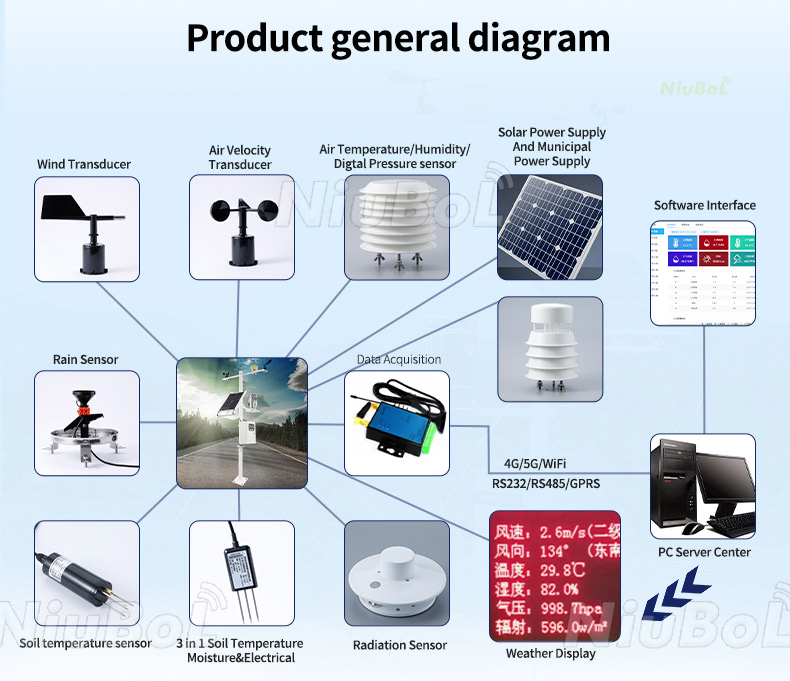

— Products —
 Consumer hotline +8618073152920
Consumer hotline +8618073152920 WhatsApp:+8615367865107
Address:Room 102, District D, Houhu Industrial Park, Yuelu District, Changsha City, Hunan Province, China
All products
Rain gauges are crucial components of weather stations, providing essential data on precipitation, which is vital for meteorological research, agriculture, water resource management, and flood forecasting. For a weather station, selecting the right type of rain gauge depends on the accuracy required, the environmental conditions, and the specific applications of the data. Here's a brief overview of the types of rain gauges suitable for weather stations and their characteristi···
Tel/WhatsApp:+8615367865107
Email:Arvin@niubol.com +Nearly 100 partner company in more than 68 countries. We are committed to providing high-quality, practical products to meet your needs and help you solve problems.Product Details
Rain gauges are crucial components of weather stations, providing essential data on precipitation, which is vital for meteorological research, agriculture, water resource management, and flood forecasting. For a weather station, selecting the right type of rain gauge depends on the accuracy required, the environmental conditions, and the specific applications of the data. Here's a brief overview of the types of rain gauges suitable for weather stations and their characteristics:

|

|

|
| ABS Tipping bucket rain gauge sensor | Tipping bucket Rain gauge sensor | Piezoelectric Rain Gauge |
Tipping bucket rain gauges measure rainfall via a funnel that directs water onto a seesaw-like container. Each tip of the bucket, caused by the water's weight, represents a fixed amount of precipitation (e.g., 0.01 inches). These events are counted electronically, providing an automated way to measure and record rainfall over time.
- Applications: Widely used in automatic weather stations for continuous monitoring, especially suitable for moderate rainfall rates. However, they may not accurately measure very light or very heavy rainfall.
2. Weighing Rain Gauges
Weighing rain gauges collect precipitation in a bucket that is placed on a scale. The weight of the collected water is recorded continuously, providing a direct measure of the precipitation amount. These gauges can accurately measure a wide range of precipitation intensities, from very light drizzles to heavy downpours, including snow.
- Applications: Ideal for professional and research-grade weather stations, especially in regions experiencing a wide variety of precipitation types and intensities.
3. Optical Rain Gauges
Optical rain gauges detect precipitation by measuring the disruption of a light beam near the device. As raindrops pass through the beam, the gauge calculates the rainfall rate based on the disruption pattern.
- Applications: Useful for research applications where detailed information about raindrop size distribution is beneficial. They offer high accuracy and can effectively measure both light and heavy precipitation.







1.Measurement Unit: The measurement of rainfall is typically in millimeters (mm) or inches.The gauge is usually designed to measure rainfall over a period of 24 hours, but there are also versions that can measure shorter or longer periods.
2.Data Logging: Modern rain gauges can be equipped with electronic sensors that automatically record the rainfall data.These sensors can transmit the data in real-time to a weather station or a remote monitoring system.
3.Accuracy and Calibration: The accuracy of a rain gauge is crucial for reliable data.Regular calibration with a known standard is necessary to ensure that the gauge is providing accurate measurements.
4.Issues with Snowfall: While rain gauges are primarily used for measuring rain, they can also be used to measure snowfall by adjusting the measurement for the density of the snow.However, this is less accurate than measuring liquid precipitation.
5.Installation: Rain gauges should be installed in a location that is not obstructed by trees, buildings, or other objects that could interfere with the accurate collection of rainfall.The gauge should also be level and have a flat bottom to ensure proper water collection.
6.Multiple Gauges: In areas with a high risk of heavy rainfall or in research applications, multiple rain gauges may be installed in different locations to provide a more comprehensive picture of the rainfall distribution.
7.Integration with Weather Stations: Rain gauges can be integrated with other weather station sensors to provide a complete meteorological dataset, which is valuable for forecasting, water resource management, and climate studies.
When choosing a rain gauge for a weather station, consider the following factors:
Accuracy Requirements: Determine the level of accuracy needed for your applications.
Maintenance: Consider how often the device needs maintenance, especially in remote or hard-to-reach areas.
Data Collection and Transmission: Automated gauges with data logging and transmission capabilities are essential for real-time monitoring and integration with other weather station data.
Environmental Conditions: Ensure the chosen rain gauge can withstand the local weather conditions, including extreme temperatures, wind, and potential for snow and ice.
Budget: Weigh the costs against the benefits of higher accuracy and lower maintenance devices.
Integrating the appropriate rain gauge into a weather station enhances the quality and reliability of meteorological data, supporting better decision-making in various sectors affected by weather conditions.

Overall, rain gauges are simple yet essential tools for collecting data on precipitation, which is vital for a wide range of economic, agricultural, and environmental activities.
NBL-W-ARS-Tipping-bucket-rain-gauge-instruction-manual.pdf
Sensors & Weather Stations Catalog
Agriculture Sensors and Weather Stations Catalog-NiuBoL.pdf
Weather Stations Catalog-NiuBoL.pdf
Related recommendations
 Multi-Depth Soil Sensor RS485
Multi-Depth Soil Sensor RS485 TDR Soil Moisture Sensor
TDR Soil Moisture Sensor Pyranometer Solar Radiation Sensors
Pyranometer Solar Radiation Sensors Soil ph sensor
Soil ph sensor Tipping Bucket Rain Gauge
Tipping Bucket Rain Gauge Air Temperature and Humidity Sensor
Air Temperature and Humidity Sensor
Screenshot, WhatsApp to identify the QR code
WhatsApp number:+8615367865107
(Click on WhatsApp to copy and add friends)